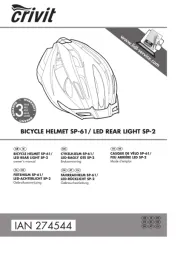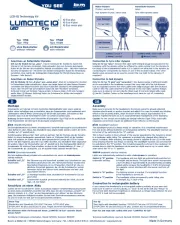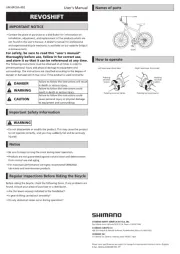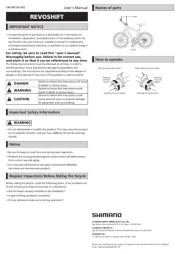Park Tool TM-1 Bruksanvisning
Park Tool
cykeltillbehör
TM-1
Läs gratis den bruksanvisning för Park Tool TM-1 (6 sidor) i kategorin cykeltillbehör. Guiden har ansetts hjälpsam av 25 personer och har ett genomsnittsbetyg på 4.2 stjärnor baserat på 13 recensioner. Har du en fråga om Park Tool TM-1 eller vill du ställa frågor till andra användare av produkten? Ställ en fråga
Sida 1/6

5115 Hadley Ave. N., St. Paul, MN 55128 (USA) www.parktool.com
PARK TOOL CO. 5115 Hadley Ave. N., St. Paul, MN 55128 (USA) www.parktool.com
PARK TOOL CO.
TM-1 Tension Meter
The TM-1 can be used to accurately and reliably
measure the tension of each spoke in a wheel, the
average tension of all the spokes in a wheel, and the
relative tension between all the spokes in the wheel.
It works on nearly any bicycle spoke, no matter
what the diameter, material, or shape.
SPOKE TENSION
Wheels that are strong, reliable and long-lasting
have spokes that are properly tensioned. Tension is
the amount of force pulling on a wheel’s spokes. Spokes that have low tension
will continue to loosen as the bike is ridden, resulting in shortened spoke life
and a wheel that requires continuous re-truing. Spokes that have too much
tension can result in deforming and/or cracks near the nipple holes of the rim,
around the flange of the hub, and at the wrench flats of the spoke nipple.
In addition to achieving proper spoke tension, it is also important for all
the spokes in the wheel to have approximately the same relative tension.
Relatively great differences in tension between each of the spokes will result
in a wheel that is not laterally stable and that will come out of true more
easily and more frequently.
The recommended tension for spokes in bicycle wheels can be as low as 80
kilograms force (kgf) and as high as 130 kilograms force. As a rule of thumb, it
is best to set tension as high as the weakest link in the system will allow, which
for a bicycle wheel is usually the rim. Therefore, to obtain a spoke tension
recommendation for a specific wheel, it is best to contact the rim manufacturer.
MEASURING TENSION OF A SPOKE
1. Measure the diameter of the spoke using the included spoke diameter
gauge. The smallest slot the spoke fits into determines the diameter. For
butted spokes, measure the narrowest portion of the spoke. A measuring
caliper can also be used to measure the spoke diameter.
2. Hold the TM-1 horizontally (flat). Squeeze the TM-1 at the handle grips
(ref. #17) as in Picture 1. Place the spoke between the two fixed posts
(ref. #3) and the moveable post (ref. #4) as in Picture 2. Gently release
handles. NOTE: With butted spokes, position the posts so they rest on the
narrowest portion of spoke. With aero/bladed spokes, position the posts
so they rest against the wide, flat side of the spoke.
3. With the TM-1 engaged on the spoke, the pointer (ref. #14) will be pointing
to a number on the tool’s graduated scale. This number is a deflection
reading that is used in conjunction with the TM-1’s conversion table to
determine the actual tension of the spoke.
4. Using the conversion table, find the column corresponding to the material
and diameter of the spoke being measured. Follow the column down to
the row corresponding to the spoke’s deflection reading (as determined
in step 3). The number at this intersection is the actual tension of the
spoke in kilograms force (kgf).
* Other units of force sometimes used are Newtons and pounds force. One
kilogram force is approximately equal to 10 Newtons or 2.2 pounds force.
MEASURING AVERAGE SPOKE TENSION
The average tension is the sum of the individual spoke tension measurements,
divided by the number of spokes measured. Each wheel has two averages,
one for the left side spokes and one for the right side spokes. If the spoke hole
flanges of the hub are centered between the locknuts of the hub, it is possible
for the left and right sides to have nearly equal average tension. However,
if the spoke hole flanges are not centered between the locknuts of the hub,
such as on most rear wheels and front wheels with disc brake mounts, it is
not possible to have the same tension between left and right side spokes.
To determine average tension:
1. Take deflection readings of all the spokes on the right side of the wheel.
Record these numbers.
2. Add the recorded numbers together.
3. Divide the sum of the recorded numbers by the number of spokes
measured. This number is the average of the deflection readings.
4. Use the conversion table to convert the average deflection reading into
the average spoke tension in kilograms force.
5. Repeat steps 1–4 for the left side of the wheel.
MEASURING RELATIVE SPOKE TENSION
Relative tension is the tension of a spoke in comparison to the tension of one
or more other spokes. A wheel with spokes that are within plus or minus
20% of the wheel’s average spoke tension is generally considered to have
acceptable relative tension. As explained on page 3, the spokes on one side
of a wheel may be tensioned differently than the spokes on the opposite side.
Therefore, it is important to only compare the tension of a spoke relative to
spokes on the same side of the wheel.
To determine relative tension:
1. Determine the average tension of the spokes on the right side of the wheel.
2. Multiply the average tension by .8 and by 1.2. The resulting two numbers
will provide the acceptable relative tension range.
3. Use the TM-1 to take deflection readings of each individual spoke and
use the conversion chart to convert the readings into individual tension
measurements.
4. Determine if the individual tension measurements fall within the
acceptable relative tension range from step 2.
5. Repeat steps 1–4 for the left side of the wheel. If the spokes are not
within the acceptable range of relative tension, adjustments need to be
made to the tension of the spokes
NOTES:
These instructions provide basic information for using the TM-1 Tension
Meter. For a thorough discussion on use of the TM-1, as well as updated
calibration tables and information on a variety of wheel topics, visit the Park
Tool web site: (www.parktool.com).
The TM-1 Tension Meter is calibrated at the Park Tool manufacturing facility.
Do not readjust the spring, spring adjustment screw or any other parts. If the
tool is worn or damaged and appears to be inaccurate, return to Park Tool for
recalibration. Park Tool will recalibrate and return the tool for a reasonable charge.
The TM-1 Tension Meter is a precision measuring instrument and should
be used and stored with care. To avoid damage, it is recommended that the
TM-1 be stored in it’s original packaging or suspended from a bench hook. It
should always be kept clean and dry.
TM-1 Instructions / Instructions / Anleitung / Instrucciones
1 2
Produktspecifikationer
| Varumärke: | Park Tool |
| Kategori: | cykeltillbehör |
| Modell: | TM-1 |
Behöver du hjälp?
Om du behöver hjälp med Park Tool TM-1 ställ en fråga nedan och andra användare kommer att svara dig
cykeltillbehör Park Tool Manualer

10 September 2024

10 September 2024

9 September 2024

9 September 2024

9 September 2024

8 September 2024

8 September 2024

8 September 2024

8 September 2024

8 September 2024
cykeltillbehör Manualer
- Kryptonite
- Topeak
- Kemo
- Powerfix
- Axa
- Tacx
- Vermeiren
- Shimano
- SBS
- Trelock
- Knog
- Busch + Müller
- SECURITY Plus
- Giant
- Fiamma
Nyaste cykeltillbehör Manualer

19 Oktober 2025

16 Oktober 2025

10 Oktober 2025

26 September 2025

15 September 2025

15 September 2025

12 September 2025

12 September 2025

12 September 2025

11 September 2025